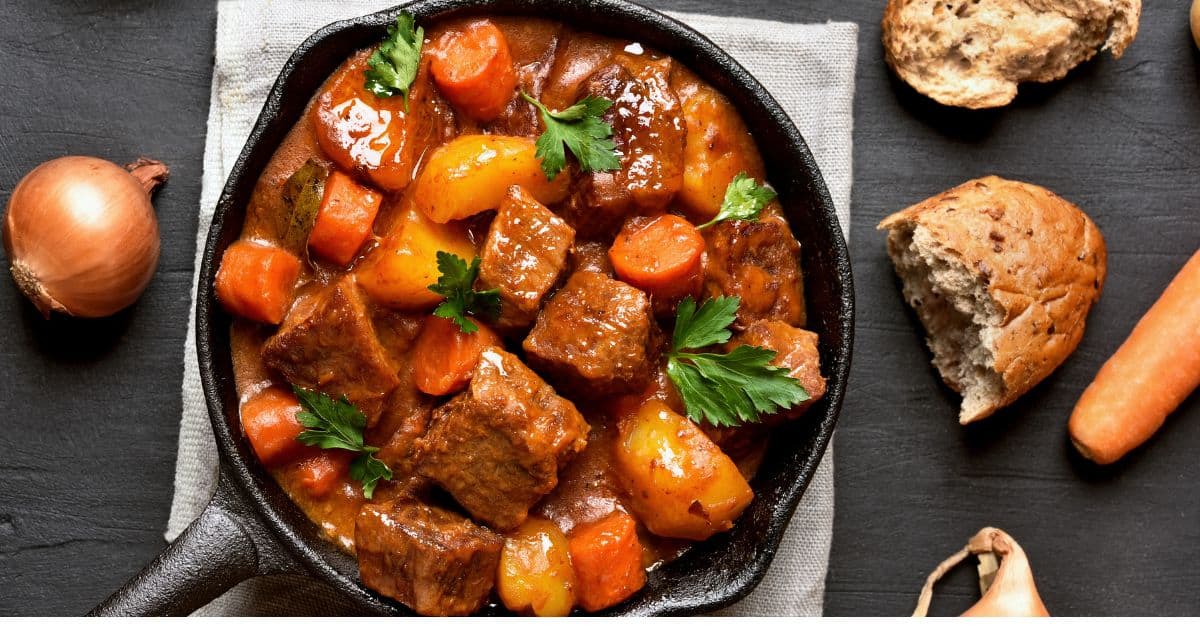We’re reader-supported. When you buy through links on our site, we may earn an affiliate commission.
Beef stew is a timeless comfort food loved by many. In today’s fast-paced world, finding time-saving and cost-effective cooking methods is more important than ever. This blog post is dedicated to showcasing how preparing freeze dried beef stew satisfies your taste buds and respects your time and wallet. We’ll explore tips and techniques to rehydrate a delicious beef stew that’s both efficient and economical without compromising flavor. Learn our tips and tricks, from selecting the right cuts of meat to using kitchen staples creatively to rehydrate your stew for the best results. We’ll guide you through a process that transforms simple ingredients into a hearty, nourishing meal.
Perfect for busy weeknights, on the trail, or added to your emergency pantry. Freeze dried beef stew promises to deliver satisfaction in every spoonful. It’s perfect for those days when you don’t have time to cook from scratch but crave the comforting taste of homemade stew. It’s also an excellent backup meal for unexpected guests or situations where cooking facilities are limited.
Freeze drying has revolutionized the way we store and enjoy classic dishes like beef stew. This method extends the shelf life of beef stew and preserves its taste, texture, and nutritional value, making it an excellent option for various situations.
What is Freeze Drying?
Freeze drying, also known as lyophilization, is a preservation method that involves freezing raw or prepared foods and then removing the water content through a process called sublimation. Here’s how it works for beef stew:
- Freezing: The beef stew is rapidly frozen, locking in flavor and maintaining the structure of the ingredients.
- Vacuum and Low Heat: The frozen stew is placed under a vacuum. Heat is applied, allowing the frozen water in the stew to sublimate, turning directly from ice to vapor without passing through a liquid phase.
- Dehydrated Stew: The end result is a completely dehydrated beef stew, with the water content removed but the flavors and nutrients intact.
Benefits of Freeze Drying Beef Stew
- Long Shelf Life: Without moisture, the stew can be stored for years without refrigeration.
- Nutrient Retention: Vitamins, minerals, and the natural flavor of the stew are largely preserved.
- Lightweight: The removal of water makes it lightweight and easy to transport.
- No Additives Required: Unlike other preservation methods, freeze drying doesn’t require any preservatives.
Best Meat for Beef Stew

Creating the perfect freeze dried beef stew starts with selecting the right cuts of meat. The adage “quality in is quality out” holds true, as the better the meat, the more flavorful and satisfying the stew will be once rehydrated.
Stew meats are tough cuts of meat with high-fat content and rich flavor. There are many cuts of beef to choose from, and they vary in cost. Here’s a list of the best cuts of meat for freeze dried beef stew:
Chuck Roast
This meat is taken from the shoulder and has a high toughness and medium fat content. Renowned for its rich flavor and marbling, chuck roast becomes tender and juicy when slow-cooked, making it an ideal choice for stew. It is more expensive than Round but still has a lower cost.
Brisket
Cut from the breast or chest of the cow and are typically inexpensive. Known for its hearty texture and robust flavor. A whole brisket can be used for stew, or you can choose between flat and point cuts. With a better ratio of tough tissue and fat content, the point cut is better for stewing than the less fatty flat cut.
Round (top and bottom)
A leaner option, round cuts are taken from the cow’s rear legs and offer a firmer texture. They are great for those who prefer a less fatty stew while retaining good flavor. It is also a lower-cost option.
Bone-in Short Ribs
These are from the underbelly of the cow. They are expensive but have an ideal ratio of toughness and fat with a rich flavor, making them excellent for stew. The bone adds flavor, and the meat, rich in connective tissues, becomes extremely tender.
Oxtail
These cuts are very tough cuts taken from the tail of the cow. Known for its gelatinous richness, oxtail adds a unique texture and depth of flavor to beef stew. ]A very high-fat content enhances the overall taste. Due to their low availability, they are expensive and often hard to find.
Sirloin
These are tender and flavorful cuts taken from the back of the cow. They fall between chuck and round roast for toughness and fat content, providing a leaner yet satisfying component to the stew. This cut is more expensive.
Stewing Beef
Pre-cut stewing beef, often from various primal cuts, is a convenient option. It’s essential to choose higher quality for the best results.
Ground Beef
Ground beef is a more economical option; it is versatile and absorbs flavors well, making it a suitable choice for a hearty stew. It’s important to brown it first for the best taste and texture.
Remember, while quality is key, the cooking and freeze drying process can tenderize and enhance even less expensive cuts, making them a viable option for delicious beef stew.
My Favorite Beef Stew Recipe
This is a hearty beef stew that is both flavorful and comforting. This recipe serves about 4-6 people.
Ingredients
- 2 lbs beef chuck, cut into 1-inch cubes
- 1/4 cup all-purpose flour
- 2 tablespoons olive oil
- 1 large onion, chopped
- 3 cloves garlic, minced
- 4 cups beef broth
- 2 tablespoons tomato paste
- 1 cup red wine (optional, can be replaced with extra beef broth)
- 3 carrots, peeled and sliced
- 2 potatoes, peeled and cut into cubes
- 1 teaspoon dried thyme
- 1 bay leaf
- Salt and pepper, to taste
- 1 cup frozen peas
- 2 tablespoons fresh parsley, chopped (for garnish)
Instructions
- Prepare the Beef: In a large bowl, toss the beef cubes with flour, salt, and pepper until they are well coated.
- Brown the Beef: Heat olive oil in a large pot over medium-high heat. Add the beef in batches, browning it on all sides. Remove the browned beef and set aside.
- Sauté Vegetables: In the same pot, add the onion and garlic, and cook until softened about 5 minutes.
- Deglaze and Simmer: Add the tomato paste and red wine (if using), scraping up any browned bits from the bottom of the pot. Add the beef broth, carrots, potatoes, thyme, bay leaf, and the browned beef along with any accumulated juices. Bring to a boil, then reduce heat to low and simmer, covered, for about 1.5 to 2 hours or until the beef is tender.
- Final Touches: Remove the bay leaf. Add the frozen peas and cook for an additional 5 minutes. Adjust seasoning with salt and pepper.
Notes
- Wine Selection: A dry red like Cabernet Sauvignon or Merlot works well if using wine.
- Thickening the Stew: If you prefer a thicker stew, you can mix a tablespoon of cornstarch with two tablespoons of water and stir it into the stew towards the end of cooking.
- Storage: This stew can be refrigerated for up to 3 days, and it often tastes even better the next day as the flavors meld together. I usually freeze dry on day 2 so the flavors can develop before the freeze drying process. I often double the recipe and eat some immediately, and then freeze dry the leftovers.
- Sometimes, I like to substitute mini gnocchis for the potatoes. This saves time on preparation, but the starches in the gnocchis also act as a thickening agent to the broth as the gnocchi cooks. Add the uncooked gnocchi after removing the bay leaf and adding the frozen peas.
How to Freeze Dry Beef Stew at Home
Freeze drying beef stew is a meticulous process that preserves its flavor, texture, and nutrients for short or long-term storage. The process requires specialized equipment, typically a freeze dryer, which can be a significant investment. Here are the steps to freeze dry beef stew:
Ingredients
- Prepared beef stew (ensure it’s cooled down before freeze-drying)
Equipment
A home freeze dryer
The Harvest Right Home Freeze Dryer has revolutionized the concept of food preservation in the home kitchen, offering ease and comfort for those looking to embrace the benefits of freeze drying. This innovative appliance allows users to freeze dry various foods, from fruits, vegetables and meat to complete staples like milk and eggs and even meals like stews and casseroles, right in the comfort of their homes.
While it represents an initial investment, the long-term savings in time and money are substantial. By enabling users to buy in bulk, preserve seasonal produce, and reduce food waste, the Harvest Right Freeze Dryer is a cost-effective solution over time. Additionally, it saves time by providing a straightforward, automated process, allowing busy individuals to preserve large amounts of food with minimal effort.
The device is designed for user-friendly operation, making it accessible even to those new to freeze drying.
Steps to Freeze Dry Beef Stew
- Prepare the Beef Stew: Cook your beef stew as you usually would. Make sure it’s thoroughly cooked and cooled down before freeze drying.
- Portion the Stew: Divide the stew into smaller, manageable portions. This ensures that the freeze drying process is uniform and efficient.
- Pre-Freezing: Although not necessary, pre-freezing your stew can speed up the freeze-drying process. Spread the stew on freeze dryer trays and place them in your freezer until completely frozen. ( Tray lids make this much more manageable.)
- Loading the Freeze Dryer: Place the frozen trays of beef stew into the freeze dryer. Make sure they are arranged in a single layer for even drying.
- Freeze Drying Process: Start your freeze dryer. The machine will first create a deep vacuum around the food and then slowly warm the shelves. This process causes sublimation, where the ice crystals in the stew turn directly into vapor, bypassing the liquid phase.
- Drying Phase: After the initial freezing, the dryer increases the temperature slightly to ensure all moisture is removed from the stew. This phase is crucial for the longevity of the freeze-dried stew.
- Check for Dryness: Once the cycle is complete, check a piece of meat and a vegetable from the stew to ensure they are completely dry. If there’s any moisture, you’ll need to continue the drying cycle.
Notes
- The freeze drying process can take anywhere from 20 to 40 hours, depending on the quantity and type of food.
- Freeze drying at home can be an investment in both equipment and time, but it’s a fantastic way to preserve your favorite meals for future use.
Packaging and Storing Freeze Dried Stew
Packaging freeze dried stew is a crucial step in the preservation process, as proper packaging ensures the stew retains its quality, taste, and nutritional value over time. The main goal is to protect the food from moisture, oxygen, light, and temperature fluctuations, which can lead to spoilage or a decrease in quality.
Effective packaging is vital to maximizing freeze dried beef stew’s shelf life. It safeguards the hard work put into preparing and freeze drying the food, ensuring that when you come to enjoy it, it’s as delicious and nutritious as the day it was made.
Here’s an overview of the best practices for packaging freeze dried stew:
Materials Needed
- Airtight Containers: These can be vacuum-sealable bags, canning jars, or mylar bags. The choice depends on your storage space, the amount of stew, and personal preference.
- Oxygen Absorbers: These packets effectively remove oxygen from the container, preventing oxidation and the growth of aerobic bacteria or fungi.
- Labeling Supplies: Labels or a permanent marker to note the contents and the date of freeze drying, as well as any special instructions for rehydration.
Packaging Steps
- Prepare Your Containers: Ensure your chosen containers are clean, dry, and ready for use. If using bags, have a sealing device ready.
- Portion the Stew: Divide the freeze dried stew into portions that you’ll likely use in one meal. This prevents the need to open and close the container multiple times, which can introduce moisture.
- Add Oxygen Absorbers: Place an appropriate-sized oxygen absorber packet into each container or bag. The size and number depend on the container’s size.
- Seal the Packaging: If using mylar bags, seal them using a heat sealer. If you are using vacuum seal bags, seal with your vacuum sealer. Ensure the seal is complete with no gaps. For jars, secure the lids tightly.
- Label Each Package: Write the contents and the date of freeze-drying on each package. This helps in tracking shelf life and managing inventory.
- Store in a Cool, Dry Place: Keep the packaged stew in a location away from direct sunlight and extreme temperature changes. A pantry, cupboard, or cellar can be ideal.
Shelf Life and Storage Considerations
- Properly packaged freeze-dried stew can last for years without significant degradation in quality.
- Avoid storing the stew in places with high humidity or where temperatures fluctuate widely.
- Periodically check the packaging for any signs of damage or seal failure.
Rehydrating and Enjoying Your Freeze Dried Beef Stew
Transforming freeze dried beef stew back into a savory, home-cooked meal is a culinary feat made simple with modern techniques. Although rehydrating freeze dried stew is straightforward, some methods that offer flexibility and depth in flavor can be utilized.
These methods restore the stew to its delicious, comforting state and allow for customization according to personal taste preferences. First, you can choose between water and beef broth as rehydration liquids. Both options will rehydrate your beef stew, but each choice will yield variations in the taste and texture of your meal.
Learn the process of rehydrating beef stew with only rehydration liquid and time or by using a slow cooker or pressure cooker. These methods enhance the stew’s flavor and texture, making the rehydrated dish nearly indistinguishable from its freshly cooked counterpart. Perfect for busy days, outdoor adventures, or emergency meal planning, rehydrated beef stew provides a nutritious, hearty, and satisfying meal with minimal effort.
Choosing Your Liquid: Water vs. Beef Broth
The choice of rehydration liquid plays a significant role in the final taste of the stew:
- Water: Using water is the standard method. It rehydrates the stew to its original state, preserving the initial flavors and seasonings.
- Beef Broth: Opting for beef broth enhances the richness and depth of flavor. It complements the beef and vegetables, adding a savory dimension that water alone cannot provide.
Determining the Amount of Rehydration Liquid
Determining the correct amount of rehydration liquid for freeze dried food can be accurately done by weighing the food before and after freeze drying. Initially, weigh the fresh food item and record its weight. After the freeze drying process, weigh the item again. The difference in weight represents the amount of water lost during freeze drying.
To rehydrate the food effectively, you must replace this amount of water. For example, if your fresh beef stew weighs 500 grams and the freeze dried version weighs 150 grams, it means 350 grams of water were removed. To rehydrate, you should add 350 grams (or milliliters, as 1g of water roughly equals 1ml) of liquid back into the stew. This method ensures precise rehydration, restoring the food to its original state in terms of texture, flavor, and nutritional value.
It’s particularly useful for foods where the moisture content affects the end result, like soups, stews, and sauces. Combining the precision of weighing with the simplicity of adding back the lost liquid offers an efficient way to enjoy your freeze dried foods as close to their original state as possible.
If you did not weigh your stew before and after freeze drying or if you would like to rehydrate a different-sized portion than what you previously weighed, you can still rehydrate, but it will not be a precise process. Simply weigh the amount of freeze dried stew that you would like to rehydrate and start by adding rehydration liquid 1:2 ratio. If you want a dryer stew, you can start with a 1:1 ratio and add more liquid as needed to fit your preferences.
The exact amount of liquid will depend on your desired consistency. No matter which technique you use to determine the amount of liquid necessary, start slow and experiment until you have it as you prefer.
Liquid and Time Method

Rehydrating freeze dried beef stew is a simple process:
- Add Water: Pour hot liquid directly into the freeze dried stew. The exact amount of water will depend on your desired consistency.
- Wait and Stir: Let it sit for a few minutes, stirring occasionally to ensure even rehydration.
- Ready to Eat: The stew returns to its original state with tender beef, vegetables, and a flavorful broth.
The rehydrated beef stew is surprisingly similar to freshly cooked stew, making it a fantastic option for camping trips and emergency food supplies. But I prefer to do a little more to prepare the freeze dried beef stew for weekday dinners where I have the option. Additional cooking adds more depth to the flavor and texture, making a more satisfying meal. This can be done by putting the reconstituted stew on the stove and stirring occasionally, or you can use a slow cooker or pressure cooker.
Rehydrating Beef Stew in a Slow Cooker
Using a slow cooker for rehydration is an excellent way to infuse flavors deeply and evenly:
- Prepare the Ingredients: Place the freeze dried beef stew in the slow cooker.
- Add Liquid: Pour enough hot liquid over the freeze dried stew to cover it completely.
- Slow Cook to Perfection: Set your slow cooker on a low heat setting. Let the stew rehydrate slowly, typically for a few hours, allowing all the ingredients to absorb the liquid fully and meld together harmoniously.
Pressure Cooker Rehydration Method

Using a pressure cooker to rehydrate freeze dried food saves time and locks in flavors, making it an ideal method for quickly rehydrating delicious and nutritious meals.
- Measure the Food and Liquid: Determine the amount of water or broth needed for rehydration by weighing the freeze dried food as described previously, or follow the general rule of thumb to add an equal amount of liquid to the weight of the freeze-dried food.
- Preparation: Add the freeze dried food to the pressure cooker. Pour the measured amount of liquid over the food.
- Stir Gently: Mix the contents lightly to ensure the freeze dried food is fully submerged in the liquid. This helps in even rehydration.
- Seal and Cook: Close the lid of the pressure cooker and ensure it’s sealed properly. Set the cooker to a low pressure setting. The cooking time will vary depending on the type of food; however, a general guideline is to cook it for half the time you would typically cook the fresh version of that food. (I cooked for 10 minutes on the low setting)
- Natural Release: Once the cooking time is complete, turn off the heat and allow the pressure to release naturally. This step is crucial as the food continues to rehydrate during this period.
- Check and Serve: After fully releasing pressure, open the lid and check the food. It should have absorbed the liquid and returned to a state similar to its pre-freeze dried texture. If needed, you can adjust the seasoning at this point.
- Additional Cooking (if necessary): If the food is not fully rehydrated, simmer it with the lid off for a few more minutes until the desired consistency is achieved.

Tips for Pressure Cooker Success
- Avoid Overfilling: Don’t fill the pressure cooker more than halfway with food and liquid; it needs space to create steam and build pressure.
- Use Warm Liquid: Using warm water or broth can speed up the rehydration process.
- Cut Larger Pieces: If the freeze dried food is in large pieces, consider cutting them into smaller sizes for more uniform rehydration.
Tips for a Perfect Rehydrated Beef Stew
- Adjust Seasonings: After rehydration, taste and adjust the seasonings if necessary. While freeze drying often intensifies flavors, it can sometimes mute underlying flavors. A little extra seasoning can revive the stew.
- Allow Time to Blend Flavors: Whether using a slow cooker or pressure cooker, give the stew time to simmer after rehydration. This allows the flavors to meld together.
- Experiment with Add-Ins: Feel free to add fresh ingredients like herbs or a splash of wine for an extra flavor boost.
Conclusion
The freeze drying technology transforms the humble beef stew into a versatile, long-lasting culinary marvel. It’s a perfect blend of convenience and nutrition, maintaining the heartiness and comforting flavors we all love. Whether you’re an adventurer, a busy parent, or someone preparing for unforeseen circumstances, freeze dried beef stew is a reliable, tasty, and nutritious option that stands the test of time.
For more tips on rehydrating freeze dried whole meals, check out our article on Rehydrating Freeze Dried Lasagna Three Ways. There we experiment rehydrating using the Water Method, a Steaming Technique and Vacuum Sealer Marinade.




